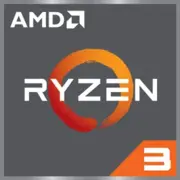AMD Ryzen 3 4100

AMD Ryzen 3 4100: Budget Processor for Basic Tasks and Gaming
Review and Recommendations for PC Builds Based on the Renoir Chip
Key Characteristics: Architecture and Performance
The AMD Ryzen 3 4100 processor, released in 2022, remains relevant as a budget solution by 2025. It is built on the Zen 2 architecture (codename Renoir) and manufactured using TSMC’s 7nm FinFET process. The chip features 4 cores and 8 threads, ensuring basic multitasking capabilities. Its clock speed ranges from 3.8 GHz (base) to 4.0 GHz in Boost mode.
Key Features:
- 4MB L3 Cache — sufficient for light gaming and office applications.
- TDP 65W — low power consumption simplifies cooling system choices.
- PCIe 3.0 Support — relevant for budget graphics cards and NVMe drives.
- AMD Technologies — Precision Boost 2, SMT (Simultaneous Multithreading).
Performance:
According to Geekbench 6 (2025), the Ryzen 3 4100 scores 1485 points in single-core and 4666 in multi-core modes. For comparison, the Intel Core i3-12100F (4 cores/8 threads) scores around ~1600 (Single) and ~4800 (Multi). The gap is not critical but noticeable in tasks sensitive to IPC (e.g., Adobe Photoshop).
Compatible Motherboards: AM4 Socket and Chipsets
The Ryzen 3 4100 uses the AM4 socket, allowing for a wide range of motherboard options.
Recommended Chipsets:
1. A520 — base option (from $60). Example: ASUS Prime A520M-K. Suitable for office PCs but does not support overclocking.
2. B550 — optimal choice (from $80). For example, MSI B550M PRO-VDH WiFi. Offers PCIe 4.0 (though the processor does not use it), along with more USB and SATA ports.
3. B450 — budget option (from $50). Motherboards like Gigabyte B450M DS3H require a BIOS update before installing the Ryzen 3 4100.
Selection Tips:
- Ensure the motherboard has BIOS version P5.00 or newer (for B450/X470).
- Any M.2 slots will suffice for PCIe 3.0 SSDs (e.g., Kingston NV1).
Supported Memory: DDR4 and Setup Nuances
The processor works with DDR4-3200 MHz (officially). In practice, many motherboards allow overclocking memory up to 3600 MHz.
Recommendations:
- Use two DDR4 modules to enable dual-channel mode (e.g., 2x8 GB).
- Optimal models: Crucial Ballistix 3200 MHz CL16 ($35 for 16 GB) or Patriot Viper Steel 3600 MHz CL18 ($40).
- DDR5 is not supported, which is a downside for future upgrades, but as of 2025, DDR4 is still relevant for budget builds.
Power Supply: Power Calculation
With a TDP of 65W, the Ryzen 3 4100 does not require a powerful power supply.
Tips:
- For a system without a discrete graphics card, a 300–400W unit will suffice (e.g., be quiet! Pure Power 11 400W, $45).
- With a graphics card of NVIDIA GTX 1650 level (TDP 75W), choose a power supply rated 500–600W (Corsair CX550, $60).
- For future upgrades (e.g., to Radeon RX 6600), it’s better to get a model with some headroom — 650W.
Pros and Cons of Ryzen 3 4100
Strengths:
- Price — $85 (new, 2025). Cheaper than Intel i3-12100F ($100).
- Energy efficiency — suitable for compact cases.
- AM4 Socket — possibility of upgrading to Ryzen 5 5600 or 5700X without changing motherboards.
Weaknesses:
- 4 cores — insufficient for streaming or 3D rendering.
- PCIe 3.0 — limits the speed of modern SSDs and graphics cards (e.g., RTX 4060 loses 5-7% performance on PCIe 3.0).
- No integrated graphics — a discrete graphics card is mandatory.
Use Scenarios: Who is This Processor For?
1. Office Tasks — document work, browsing (20+ tabs), Zoom.
2. Light Gaming — CS2, Fortnite, GTA V on medium settings (with GPU level of GTX 1660 Super).
3. Multimedia — watching 4K video, editing videos in DaVinci Resolve (with basic effects).
4. Home Server — low power consumption is suitable for a NAS based on Proxmox.
Example Build (2025):
- CPU: Ryzen 3 4100 ($85).
- Motherboard: MSI B550M PRO-VDH WiFi ($90).
- Memory: TeamGroup T-Force Vulcan Z 16 GB DDR4-3200 ($35).
- Graphics Card: AMD Radeon RX 6500 XT ($150).
- PSU: EVGA 500 BR ($45).
- Total: ~$405 (excluding case and storage).
Comparison with Competitors
1. Intel Core i3-12100F ($100):
- Pros: Higher IPC, better in single-threaded tasks.
- Cons: More expensive, LGA 1700 socket is less promising.
2. AMD Ryzen 5 5500 ($120):
- 6 cores/12 threads, Zen 3. Better for multitasking, but 40% more expensive.
3. Intel Pentium Gold G7400 ($70):
- 2 cores/4 threads. Lags in gaming and multithreaded performance.
Conclusion: The Ryzen 3 4100 is a sweet spot between price and performance.
Practical Build Tips
1. Don’t skimp on the motherboard. B550 will provide headroom for future upgrades.
2. Choose an SSD with PCIe 3.0 — for example, WD Blue SN570 (1TB, $50).
3. Check cooler compatibility. The stock cooler will suffice, but for quiet operation, consider getting a DeepCool AG400 ($20).
4. Update the BIOS in advance if you’re getting a B450/X470 motherboard.
Conclusion: Who is the Ryzen 3 4100 Suitable For?
This processor is an ideal choice for:
- Budget gamers playing at 1080p.
- Office PCs with potential for upgrades.
- Users building a system “for now” with minimal investment.
Alternative: If the budget allows $120–150, it’s better to choose the Ryzen 5 5500 or the Intel i3-13100F. But at $85, the Ryzen 3 4100 remains the best in its category, combining price, energy efficiency, and sufficient power for everyday tasks.
Basic
CPU Specifications
Memory Specifications
GPU Specifications
Miscellaneous
Benchmarks
Compared to Other CPU
Related CPU Comparisons
Share in social media
Or Link To Us
<a href="https://cputronic.com/en/cpu/amd-ryzen-3-4100" target="_blank">AMD Ryzen 3 4100</a>

